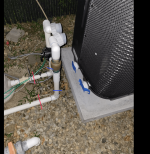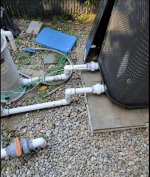Hi, I just got a heat pump to replace my broken gas heater and I have the skill to do the electrical but not so much the plumbing. I was supposed to have a plumber do it but he cancelled until late next week and we are in the middle of a cold spell in my area so I would love to use it. It looks simple enough but I need some guidance.
I bought a new check valve as this one is old and there is no pipe to put a coupler on. The 3 way valve is about 7 years old, should I replace it? It has enough pipe on all 3 sides I could reuse it with couplers.
Unfortunately I dont think there is enough clearance to cut at the blue lines and then build the bypass manifold and connect to the heat pump. I could move the heat pump to the right in the photo more but then it wouldnt have as good of clearance on all sides.
I was thinking I should cut at the red lines, then attach right angles to raise it up to the height of the heat pump unions and then build the manifold horitzontally and then connect.
I think my biggest issue doing this kind of plumbing and what I had an issue with when it came to the SWG install (it ended up a little crooked but worked) is that a) the glue sets up so fast that i have no time to get it all straight, and obviously this bypass manifold needs to be straight.
Any guidance or tips would be appreciated, especially the order I should build and glue things. Like should I make the manifold seperate first or start from the left and work my way right?
I figure one thing that helps is that thhe pipes appear to be the correct width for the unions on the heat pump and also i can move the heat pump around if needed to get it to fit.
Thanks

I bought a new check valve as this one is old and there is no pipe to put a coupler on. The 3 way valve is about 7 years old, should I replace it? It has enough pipe on all 3 sides I could reuse it with couplers.
Unfortunately I dont think there is enough clearance to cut at the blue lines and then build the bypass manifold and connect to the heat pump. I could move the heat pump to the right in the photo more but then it wouldnt have as good of clearance on all sides.
I was thinking I should cut at the red lines, then attach right angles to raise it up to the height of the heat pump unions and then build the manifold horitzontally and then connect.
I think my biggest issue doing this kind of plumbing and what I had an issue with when it came to the SWG install (it ended up a little crooked but worked) is that a) the glue sets up so fast that i have no time to get it all straight, and obviously this bypass manifold needs to be straight.
Any guidance or tips would be appreciated, especially the order I should build and glue things. Like should I make the manifold seperate first or start from the left and work my way right?
I figure one thing that helps is that thhe pipes appear to be the correct width for the unions on the heat pump and also i can move the heat pump around if needed to get it to fit.
Thanks



